
"Jabberwocky" is a nonsense poem written by Lewis Carroll about the killing of a creature named "the Jabberwock". It was included in his 1871 novel Through the Looking-Glass, the sequel to Alice's Adventures in Wonderland (1865). The book tells of Alice's adventures within the back-to-front world of Looking-glass world.

Through the Looking-Glass, and What Alice Found There is a novel published on 27 December 1871 by Lewis Carroll, a mathematics professor at the University of Oxford, and the sequel to Alice's Adventures in Wonderland (1865). Alice again enters a fantastical world, this time by climbing through a mirror into the world that she can see beyond it. There she finds that, just like a reflection, everything is reversed, including logic.
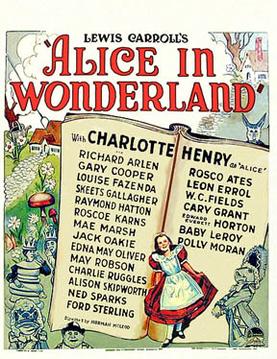
Alice in Wonderland is a 1933 American pre-Code fantasy film adapted from the novels by Lewis Carroll. The film was produced by Paramount Pictures, featuring an all-star cast. It is all live action, except for the Walrus and The Carpenter sequence, which was animated by Harman-Ising Studio.

The Hatter is a fictional character in Lewis Carroll's 1865 book Alice's Adventures in Wonderland and its 1871 sequel Through the Looking-Glass. He is very often referred to as the Mad Hatter, though this term was never used by Carroll. The phrase "mad as a hatter" pre-dates Carroll's works. The Hatter and the March Hare are referred to as "both mad" by the Cheshire Cat, in Alice's Adventures in Wonderland in the sixth chapter titled "Pig and Pepper".
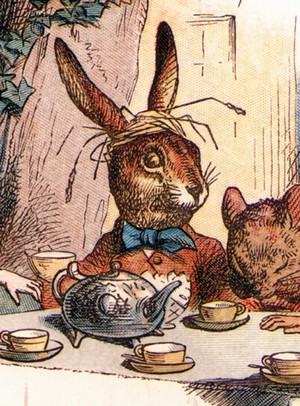
The March Hare is a character most famous for appearing in the tea party scene in Lewis Carroll's 1865 book Alice's Adventures in Wonderland.

Alice in Wonderland is a 1951 American animated musical fantasy comedy film produced by Walt Disney Productions and based on the Alice books by Lewis Carroll. The 13th release of Disney's animated features, the film features the voices of Kathryn Beaumont, Ed Wynn, Richard Haydn, Sterling Holloway, Jerry Colonna, Verna Felton, J. Pat O'Malley, Bill Thompson, and Heather Angel. The film follows a young girl named Alice who falls down a rabbit hole to enter Wonderland, ruled by the Queen of Hearts. Along the way, she encounters an odd assortment, including the Mad Hatter and Cheshire Cat.

Adventures in Wonderland is a 1992–1995 American live-action/puppet musical television series based on the novels Alice's Adventures in Wonderland (1865) and Through the Looking-Glass (1871) by Lewis Carroll as well as the 1951 animated film. In the series, Alice, is portrayed as a girl who can come and go from Wonderland simply by walking through her mirror.

Lewis Carroll's books Alice's Adventures in Wonderland (1865) and Through the Looking-Glass (1871) have been highly popular in their original forms, and have served as the basis for many subsequent works since they were published. They have been adapted directly into other media, their characters and situations have been appropriated into other works, and these elements have been referenced innumerable times as familiar elements of shared culture. Simple references to the two books are too numerous to list; this list of works based on Alice in Wonderland focuses on works based specifically and substantially on Carroll's two books about the character of Alice.

Fushigi no Kuni no Alice is an anime adaptation of the 1865 novel Alice's Adventures in Wonderland which ran on the TV Tokyo network and other local stations across Japan from October 10, 1983 to March 26, 1984. The series was a Japanese-German co-production between Nippon Animation, TV Tokyo and Apollo Films. The series consists of 52 episodes, however, only 26 made it to the US.
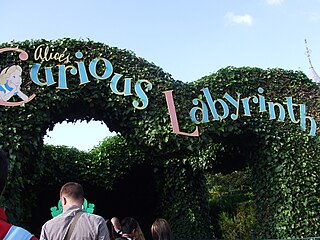
Alice's Curious Labyrinth is a hedge maze attraction at the Disneyland Park within Disneyland Paris. It opened in 1992 with the Park, and belongs to the British part of Fantasyland. A similar maze attraction, based on both the 1951 and 2010 Disney film adaptations of Lewis Carroll's Alice in Wonderland, exists at Shanghai Disneyland Park.

"Twinkle, Twinkle, Little Bat" is a poem recited by the Mad Hatter in chapter seven of Lewis Carroll's 1865 novel Alice's Adventures in Wonderland. It is a parody of "Twinkle Twinkle Little Star".

Alice in Wonderland is a musical by Henry Savile Clarke, Walter Slaughter (music) and Aubrey Hopwood (lyrics), based on Lewis Carroll's books Alice's Adventures in Wonderland (1865) and Through the Looking-Glass (1871). It debuted at the Prince of Wales Theatre in the West End in 1886.

Alice in Wonderland is a 1915 American silent dark fantasy adventure film adaptation of Lewis Carroll's classic 1865 novel, Alice's Adventures in Wonderland, directed and written by W. W. Young and starring Viola Savoy as Alice.

The Westminster Alice is the name of a collection of vignettes written by Hector Hugh Munro (Saki) in 1902 and published by The Westminster Gazette of London. It is a political parody of Lewis Carroll's two books, Alice's Adventures in Wonderland (1865) and Through the Looking-Glass (1871).
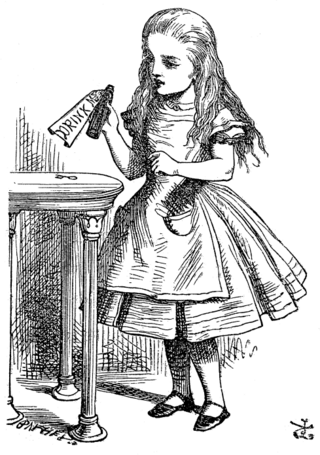
Alice, the main protagonist of Lewis Carroll's novels Alice's Adventures in Wonderland (1865) and Through the Looking-Glass (1871), has been adapted to several media.

Alice Through the Looking Glass is a 2016 American live-action/animated fantasy adventure film directed by James Bobin, written by Linda Woolverton and produced by Tim Burton, Joe Roth, Suzanne Todd, and Jennifer Todd. It is based on the characters created by Lewis Carroll and it is the sequel to Disney's 2010 live-action feature film Alice in Wonderland. Johnny Depp, Anne Hathaway, Helena Bonham Carter, Matt Lucas, Mia Wasikowska, Alan Rickman, Stephen Fry, Michael Sheen, Barbara Windsor, Timothy Spall, Paul Whitehouse, Lindsay Duncan, Geraldine James and Leo Bill reprise their roles from the previous film with Rhys Ifans and Sacha Baron Cohen joining the cast. It also features Rickman, Windsor and Andrew Sachs in their final film roles prior to their deaths. In the film, a now 22-year-old Alice comes across a magical looking glass that takes her back to Wonderland, where she finds that the Mad Hatter is acting madder than usual and wants to discover the truth about his family. Alice then travels through time, comes across friends and enemies at different points of their lives, and embarks on a race to save the Hatter before time runs out.
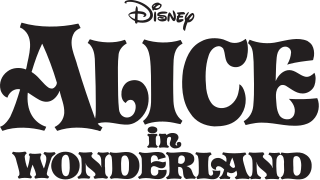
Alice in Wonderland, or simply Alice, is a Disney media franchise, commencing in 1951 with the theatrical release of the animated film Alice in Wonderland. The film is an adaptation of the books by Lewis Carroll, the 1865 novel Alice's Adventures in Wonderland and its 1871 sequel Through the Looking-Glass, which featured his character Alice. A live-action film directed by Tim Burton was released in 2010.
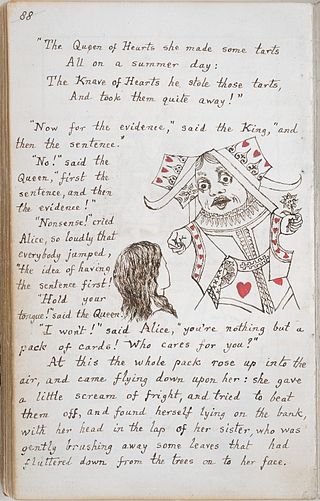
Alice's Adventures Under Ground is a 2016 one-act opera by Gerald Barry to his own libretto, based on Lewis Carroll's 1865 children's book Alice's Adventures in Wonderland and its 1871 sequel Alice Through the Looking-Glass. First performed in a concert staging at the Walt Disney Concert Hall, Los Angeles on 22 November 2016, it received its stage premiere at the Royal Opera House on 3 February 2020. The staging was a joint production by the Royal Opera House, Irish National Opera and Dutch National Opera, and was directed by Antony McDonald.
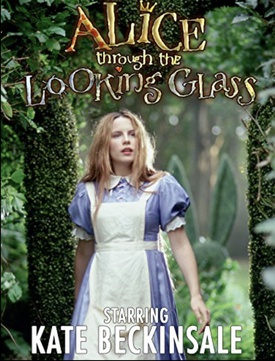
Alice through the Looking Glass is a 1998 British fantasy television film, based on Lewis Carroll's 1871 book Through the Looking-Glass, and starring Kate Beckinsale.


















